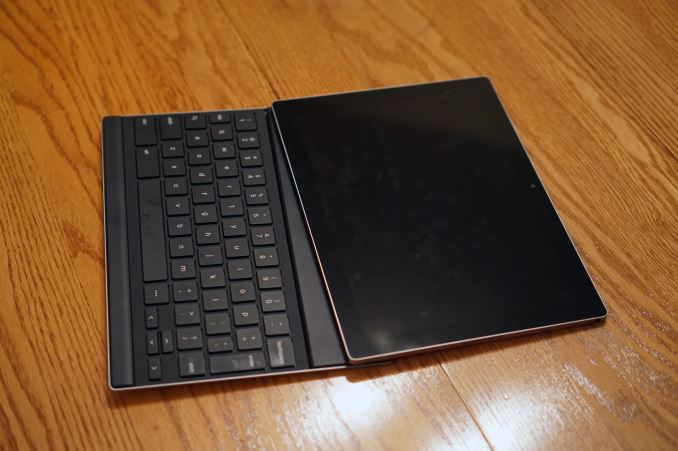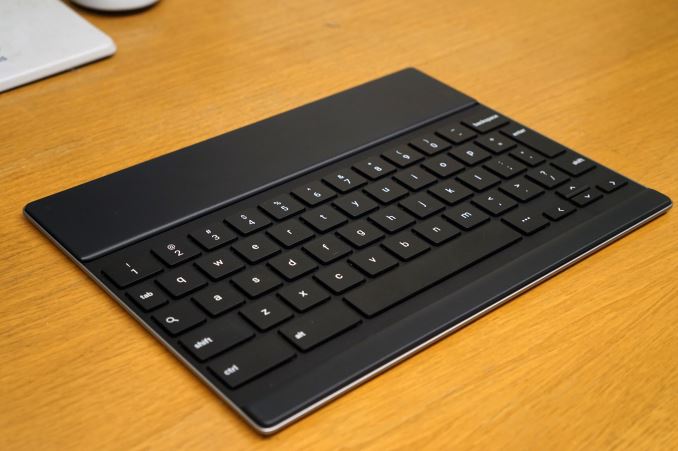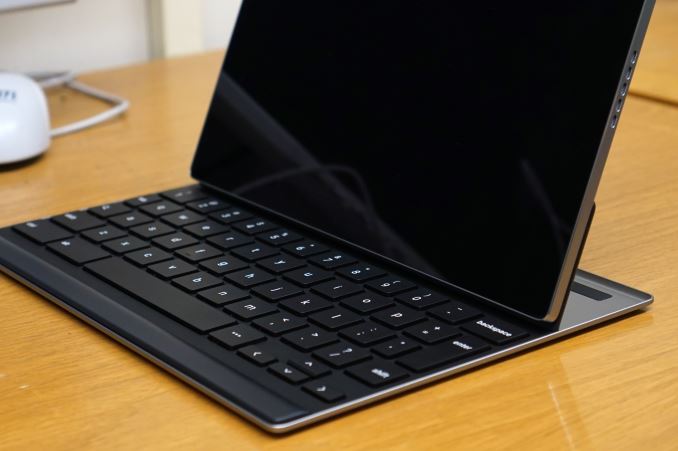The Google Pixel C Review
by Brandon Chester & Joshua Ho on January 25, 2016 8:00 AM ESTKeyboard
Part of the Pixel C’s appeal comes from the keyboard accessory. It isn’t included with the tablet itself, but this is true of most keyboards on tablets so it’s not as if the Pixel C is behind the competition in this regard. At $149 the keyboard is also well priced for one made out of machined aluminum, with full key travel and the Pixel C’s signature magnetic hinge.
Before talking about the keyboard itself, it’s probably a good idea to go over how that magnetic hinge works. The back of the Pixel C’s keyboard is a large aluminum flap with an equally large magnet on top. The best way you could describe the system is that this flap is connected to a very stiff hinge, which allows the flap to go to almost any angle up to about 85 degrees from the horizontal. The tablet has magnets embedded in its back which allow it to connect to this flap, and there’s enough strength in the connection to keep the tablet connected, as well as enough strength holding up the flap to prevent the mass of the tablet from causing it to start shifting back to a horizontal position. This system allows Google to give very fine angle adjustments without having to embed a kickstand in the Pixel C, and it’s quite a clever solution to the problem.
Of course, a unique keyboard solution does come with unique challenges. Obviously you end up with less space for the keyboard because the entire piece has to be the same size as the tablet, with a significant portion being dedicated to the magnetic flap. This is just an inherent result of the design, and while one could say it’s a waste, I would argue that the benefits of the system far outweigh this apparent downside.
The only real problem is training yourself to use the system correctly. When you put the tablet and keyboard together, you need to orient it with the tablet’s LED light bar on the same side as the keyboard’s space bar, or the keyboard won’t be able to charge using the Pixel C’s inductive charging. Unfortunately, this leads to some moments of confusion as you try to orient the tablet correctly after removing it. To split apart the keyboard and tablet Google recommends that you slide the two apart by pushing on the shorter sides of the keyboard and tablet. The first issue with this approach is that anything trapped between the keyboard and display is liable to absolutely ruin the glass, which has happened to my unit around some corners of the display.
The other issue is that once the two are separated you then need to remember to flip the tablet upward to put it in the right position to connect with the keyboard. While this seems like a natural motion, I find myself doing it incorrectly because even after sliding the two sections apart there’s still a magnetic attraction between the long edges of the tablet and keyboard, which causes me to favor rotating the tablet in order to separate them. In this case, the tablet ends up being upside down, and so you need to look at it and orient it such that the front-facing camera is on the top bezel before attaching it to the keyboard.
While some may feel that my issues working out the connection and disconnection of the keyboard are simply user error, it is worth noting that Google includes an enormous instruction sheet along with the Pixel C, and so confusion among users is clearly expected to some extent. I’ve gotten better at setting up the tablet in keyboard mode quickly, but it’s still not an action that has become a second nature to me.
Once you’ve set up the keyboard, you may notice something very familiar about it if you’ve had any experience with Google’s other Pixel products. The core part of the keyboard uses the exact same key size, pitch, and travel distance as the Chromebook Pixel. Google has shrunken the keys around the edges in order to match the keyboard to the Pixel C’s 10.2” display, but I haven’t found it to be much of a problem in use. On the contrary, I think the feel of the keyboard is great. The keys have a good tactile response, and the spacing is comfortable. In my eyes it definitely surpasses the iPad Pro’s Smart Keyboard by a large margin, although I’m not sure how well it compares to Microsoft’s Surface Type Cover.
Unfortunately, the keyboard becomes another area where the apparent mid-development switch to Android causes numerous issues. On the design side, you’ll notice that the keyboard follows the Chromebook Pixel in replacing the caps lock key with a search button. Right off the bat, I noticed a glaring issue with the implementation of this key. You can press search to open a search box anywhere, but I cannot find any way to close the search box if you open it by accident. If you open the search field you need to tap on the display to close it. There needs to be forgiveness in the design, either by making a backspace press when the field is empty close it, or by allowing you to close it by tapping search again with an empty field.
Android itself just doesn’t work very well with keyboards either. In fact, this implementation isn’t near as good as what I saw on the Dell Venue 10, and I didn’t think that provided a very good experience either. The big problem stems from the fact that Google hasn’t included proper navigation keys, which is more evidence that this device wasn’t ever meant to run Android in the first place. The omission of keys to trigger the standard home, back, and recent apps buttons is simply unacceptable. Google does have a help page online which lets you know the cryptic multiple key combos that perform these actions, but I don’t understand why a simple action like home needs to be activated by pressing search and enter, which are on entirely different sides of the keyboard. The same is true of back, which is search + backspace. Thankfully, Google does offer standard shortcuts in many of their apps, but the lack of navigational buttons on the keyboard is a big problem.
Ultimately, the Pixel C’s keyboard is a great piece of hardware, but Android doesn’t work very well with keyboards, and this keyboard in particular is ill suited to Android on top of that. Google has a very novel hinge implementation, and the inductive charging takes away the need to charge the keyboard, but many of the processes need to be streamlined and just generally made easier for the user to understand and get used to quickly. The tablet really needs to be able to attach onto and charge the keyboard without requiring a specific orientation, and the keyboard needs proper Android navigation shortcuts on top of Android simply needing much better keyboard support and applications to take advantage of one. I would love to see the ideas behind the Pixel C’s keyboard and hinge make it into keyboards from other manufacturers in the future, as well as future Android tablets that better deliver on promises of productivity abilities.














122 Comments
View All Comments
valentin-835 - Monday, January 25, 2016 - link
The tablet has issues. You kind of get what you pay for. I mean, it's half the price of an IPad Pro. And less than half that of a Surface.The biggest drawback however is the lack of an advanced graphics API like Metal or DX12. Without that, they are dead in the water. I heard Google is pushing hard to get Vulkan released. Both drivers and specification should be out soon.
styleruk - Monday, January 25, 2016 - link
Hmm, there seems to be an awful lot of points about a Google tablet or android tablet not being much more than a big phone. I have to disagree. I use the N9 for business and pleasure. I often type out reports on the N9 at airports, watch movies, read mags, books and play occasional games. I've had both android and apple phones both have good and bad points, currently on apple phone, but at work there are 2 iPad tablets I could use if I wanted, but they are simply too restricted to my needs. For me, the N5 + Google's more open approach is far more efficient. Up to now, I've had no problem with lack of multi task... to fill in my diary and read an email is simply to switch...its no biggie. If I want more I wait until I'm in front of a PC at work or home.I also like the way everything Google works together well.
Regarding this device, I'm on the cusp of upgrading my N9, but quite why I can't see yet. Until I actually pick it up and try it, I'm not ordering it, as the last upgrade was from the N7(2013), to N9, and whilst bigger, it's not really faster. On paper, the pixel C is not much faster than the N9!
The jury is still out...but stop saying that android tablets are just big phones, I have the choice and I don't agree at all.
tuxRoller - Monday, January 25, 2016 - link
Just looking at the benchmarks, your not judging this device fairly.The nexus 9 had a processor that was basically designed for benchmarking and nothing else. It just falls on its face when the code becomes branchy. Iow, benchmarks were an unusually poor indicator of typical performance.
That aside, the pixel is performs pretty much exactly where you'd expect it to perform given its CPU: between the nexus 5x and the 6p FOR MOST TESTS.
Iow, no surprises.
I'd also like to point out that the weight is only an issue if you have some physical issues, or are just used to very light tablets. I received the pixel c for Xmas and have had no issues transitioning to it from the 2013 nexus 7. My gf even noted when she first picked it up that "this isn't very heavy" (she'd read the reviews which complained about its weight).
I certainly have issues with it (it often doesn't respond to touches, sometimes the interface becomes so slow I have to force a restart) but it's still an awfully good TABLET for the price.
c4v3man - Monday, January 25, 2016 - link
I gave up on waiting for a return to sanely priced android tablets and went with a Dell Venue 11 Pro 7140. Like most non-apple products they don't hold their value particularly well, so I was able to score a Core 5M71 256GB SSD version with the keyboard for under $600. While heavier than initially anticipated, I get excellent battery life (13+ hours real world display use with the keyboard battery), and an extremely snappy tablet that even handles light Adobe Lightroom usage. That and it works on a lap, unlike a Surface, and is serviceable (good luck replacing the battery/ssd in your surface). Remix OS works on it as well if I need to get my android fix, and will likely get better with more development. I guess I don't see the point of using a more limited OS on a $500+ device... If you're going for productivity and charging a premium, give me a full experience. If it's a limited experience, it better come with a "limited" price.Jerch - Monday, January 25, 2016 - link
Always sad to see the Nexus 7 (2013) omitted from display lists, since even though it is now firmly outdated, it had a great screen that would still be at the top of some of these tests -- notably max brightness. It's the perfect beach tablet. Cheap, durable, and BRIGHT.EludiumQ36 - Monday, January 25, 2016 - link
I have a 32GB Pixel C and take it from a regular user as opposed to a professional reviewer/critic - it's a very good tablet. I use it as a true tablet sans keyboard which mitigates much of the complaining. It features a beautiful and very responsive display (utilizing Android 6.0.1). It was my perfect choice because (1) the Nexus 10 is no longer available, (2) it's far less expensive than the 10-in Samsung tablets (which are stuck on KitKat), and (3) it's basically a Nexus with first-in-line upgrades. Having said that, there is a highly reported problem of Wifi performance degradation - I experience a 60% hit but still get 26Mbps to it, so... - but they'll issue a fix for that soon enough. I highly recommend it if you count yourself as a "regular" user.R. Hunt - Tuesday, January 26, 2016 - link
Granted, Samsung is not great with updates. That out of the way, even last year's Tab S is been on Lollipop for months. And how is this less expensive than say, the Tab S2?Jumangi - Monday, January 25, 2016 - link
Google just doesn't care about making Android a good experience on larger tablets. Until,they do we will get half baked products like this and the iPad will continue to be the standard.McChen - Tuesday, January 26, 2016 - link
One thing that wasn't mentioned in the review is that the Pixel C supports faster charging (12V @ 2A, 24W) via USB PD using a charger such as the Pixel laptop charger. I have one and indeed the tablet charges very fast with it. I believe one of the Google engineers said it charges 0 to 100 in about 2.5 hours, compared to just over 4 hours in this review with the standard 15W charger. Would be interesting to see a charging time test with a USB PD charger.Jumangi - Tuesday, January 26, 2016 - link
They used the charger the device comes with as they should.